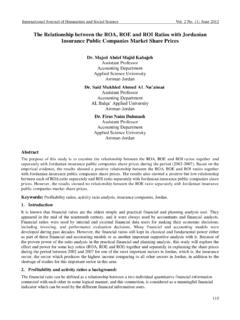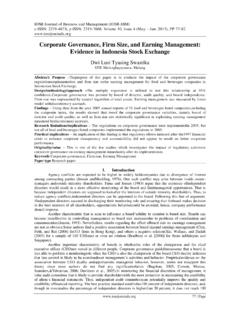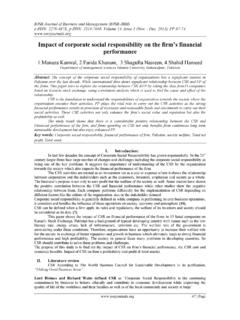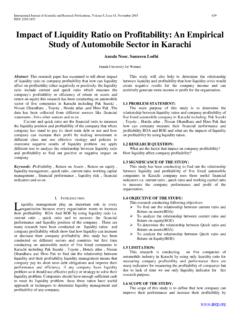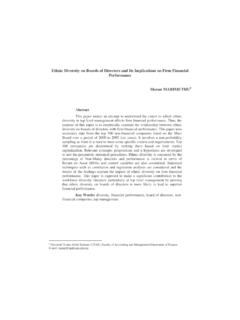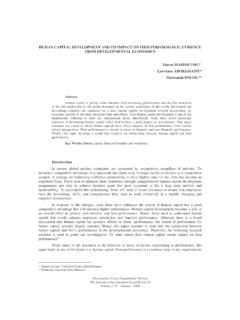Transcription of WHAT DETERMINES THE PROFITABILITY OF …
1 1 what DETERMINES THE PROFITABILITY OF BANKS? EVIDENCE FROM SPAIN Antonio Trujillo-Ponce Senior Lecturer in Finance Department of Business Administration Pablo de Olavide University rea Tem tica: b) Valoraci n y Finanzas Palabras clave: Rentabilidad bancaria; Bancos; Cajas de ahorro; Sistema bancario europeo. Keywords: bank PROFITABILITY ; Commercial banks; Savings banks; European banking system. 75b 2 what DETERMINES THE PROFITABILITY OF BANKS? EVIDENCE FROM SPAIN* Abstract This paper analyzes empirically the factors that determine the PROFITABILITY of Spanish banks for the period of 1999-2009. The results obtained by applying the system-GMM estimator to a large sample of Spanish banks indicate that the high bank PROFITABILITY during these years is associated with a large percentage of loans in total assets, a high proportion of customer deposits, good efficiency, and a low credit risk.
2 In addition, higher capital ratios also increase the bank s return, although this finding applies only when using return on assets (ROA) as the PROFITABILITY measure. We find no evidence of either economies or diseconomies of scale or scope in the Spanish banking sector. On the other hand, all industry and macroeconomic determinants, with the exception of interest rate, affect bank PROFITABILITY in the anticipated ways. Finally, our study reveals differences in the performance of commercial and savings banks. Resumen Este trabajo analiza los factores que explican la rentabilidad bancaria en Espa a para el periodo comprendido entre 1999 y 2009. Los resultados que se obtienen tras la aplicaci n de un modelo din mico para datos de panel (estimador system-GMM) a una amplia muestra de entidades espa olas indican que la alta rentabilidad alcanzada por las mismas durante esos a os se asocia con una elevada actividad crediticia (alto porcentaje de pr stamos y dep sitos en su balance), unos buenos ratios de eficiencia y una reducida tasa de morosidad.
3 Adem s, los buenos ratios de solvencia durante esos a os tambi n favorecen la rentabilidad, aunque nicamente cu ndo consideramos sta medida sobre el activo (ROA). No encontramos evidencia de econom as o deseconom as de escala y/o alcance en el sector bancario espa ol. Por otro lado, todas las variables externas, sectoriales y macroecon micas, se comportan de la manera esperada, a excepci n de los tipos de inter s. Finalmente, nuestro estudio revela diferencias cualitativas en el desarrollo de bancos y cajas de ahorro durante el periodo analizado. * This paper is a new version of a previous document entitled Why are (or were) Spanish banks so profitable?
4 3 1. Introduction In the past decade, Spanish banks have been significantly more profitable than those of the European Union as a whole (see Figure 1). In addition to this superior performance, the Spanish banking sector is among the five most important in Europe in terms of both assets managed and numbers of credit institutions, branches, and employees (see Table 1), which makes it interesting to PROFITABILITY is necessary for a bank to maintain ongoing activity and for its shareholders to obtain fair returns. However, it is also important for supervisors because it guarantees more flexible capital ratios, even in the context of a riskier business environment. This higher PROFITABILITY does not appear to have been achieved at the expense of the soundness of the banking system, which was characterized by a good level of provisions during those years.
5 The bank of Spain, being aware of the cyclical nature of credit losses, introduced dynamic provisioning (also known as statistical or generic provisioning) in 2000. This system requires banks to build up loan loss reserves in good times to be drawn on in economic downturns as losses increase. Because of this, the Spanish banks had accumulated a significant buffer, in comparison with banks in other developed countries, to cover their incurred losses when the current economic crisis began and so most of them faced the first years of the economic crisis with good levels of solvency. To better understand the underlying mechanisms of bank performance in Spain for research purposes, some background information is required.
6 Spanish banks can be grouped into two main categories: commercial banks and savings banks the so-called cajas . The savings banks were created in the 19th century as non-profit entities with the object of promoting savings and combating usury for social welfare purposes. However, today, they conduct their activity in a similar way to the commercial banks, although they are subject to certain operating limits because they must devote part of their profits to social causes. In most cases, the governance of the savings banks remains in the hands of local public authorities; hence, a high proportion of these entities focus their activities in the region where they were created, although there is greater openness to regions other than the region of origin in recent years.
7 By the end of 2009, commercial and savings banks accounted for of the total credit granted to the resident private sector and of deposits from this sector, being the savings banks market share several percentage points higher than that of the commercial banks in terms of both loans ( versus ) and deposits ( 1 Spain has the largest number of bank branches per capita in Europe: approximately per 10,000 inhabitants over 16 years of age. This high ratio is a differentiating characteristic of the Spanish banking system, which places high priority on geographic proximity to the customer. However, in recent years, many banks have reduced their numbers of offices as a result of the economic crisis given the high operating costs of maintaining such a large network.)
8 Even so, Spanish banks continue to lead the European rankings in this respect. 4 versus ). However, although at the end of the year there were 47 domestic commercial banks and 45 savings banks in Spain; during 2010 the banking sector underwent a major restructuring process involving mainly the savings banks. Forty of them participated in some type of integration process, reducing their number dramatically (17 savings banks or groups of savings banks as compared to the 45 formerly existing institutions).2 There is an abundant literature on the determinants of bank PROFITABILITY both in the USA and in Europe, as we will see in the following section. Despite this, given the present strategic importance of the Spanish banking system in Europe and because a number of years have passed since the most recent studies were conducted , Carb Valverde et al.
9 , 2007, analyze data from the Spanish market in the 1994-2001 period we believe it is appropriate to re-examine the bank PROFITABILITY drivers in Spain. In this context, our paper complements the previous literature by analyzing the factors that have allowed the Spanish banking system to be among the most profitable of the European Union from the introduction of the Euro in 1999 up to 2009, two years after the start of the current financial crisis. To do this, we use the generalized method of moments (GMM) estimator developed for dynamic panel models by Arellano and Bover (1995) and Blundell and Bond (1998), also referred to as the system-GMM estimator, which has been used in recent studies on determinants of bank PROFITABILITY ( , Garc a-Herrero et al.)
10 , 2009; Dietrich and Wanzenried, 2011)3; this econometric technique allows us to control for endogeneity and unobserved heterogeneity. On the other hand, we also investigate whether significant differences between the commercial banks and savings banks during this period can be observed that might explain the worse performance apparently demonstrated by the savings banks following the onset of the financial crisis in late 2007 savings banks operate in almost all countries, although it is in Spain where they have become more relevant in the last The paper is structured as follows. Section 2 reviews the most significant empirical studies and develops our research hypotheses. Section 3 describes the data and methodology employed in the empirical research and also defines the explanatory variables.

